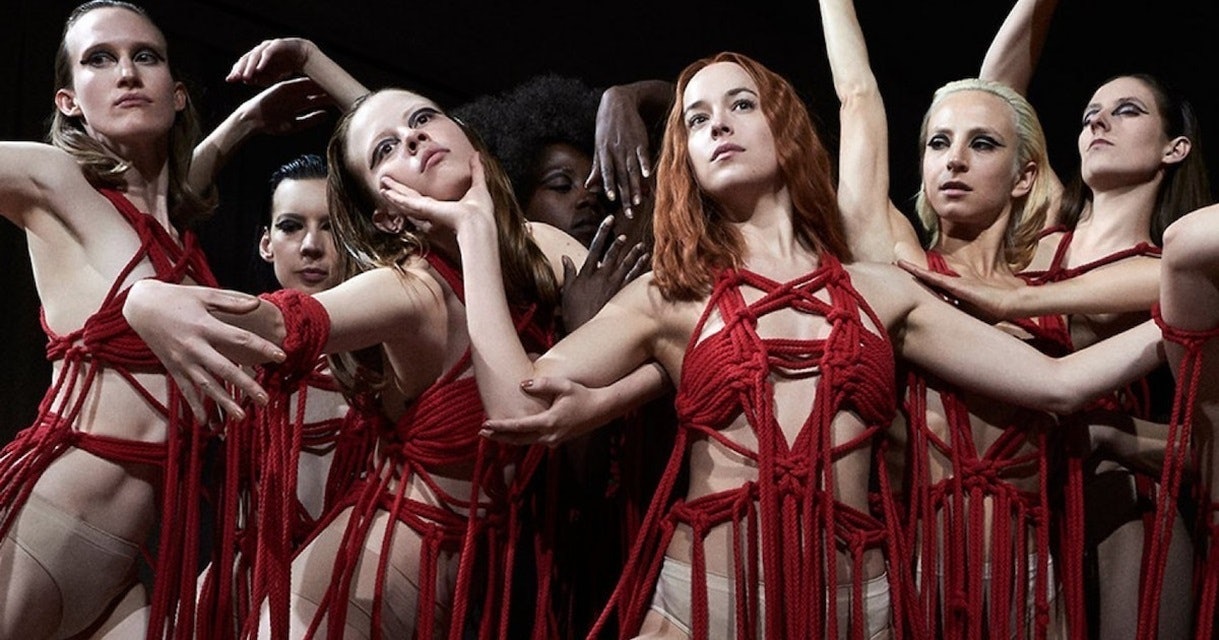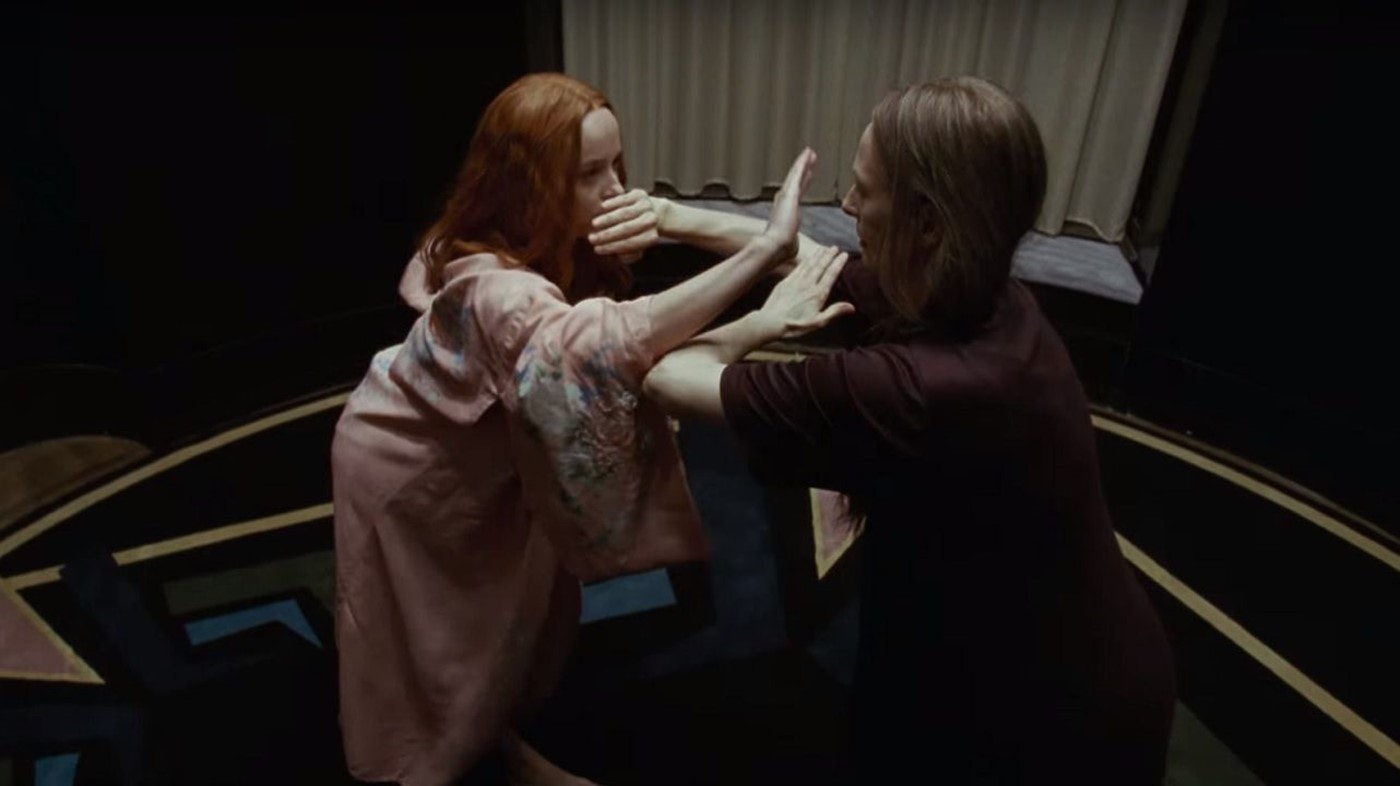
Over the last 20 years, the ubiquity of the remake has become one of the catch-all criticisms of everything wrong in Hollywood right now, a shorthand for corporate greed and studio culture’s lack of creativity. While not entirely untrue, this argument ignores the nuance of the discussion — remakes have their own utility within cinematic storytelling.
Some of the best horror films ever made have been remakes, and in most cases, the memorable ones recapture the horror of the original in unique ways. Such is the case with Luca Guadagnino’s 2018 box office bomb Suspiria, a chilling, oppressive, and methodical cinematic experience that works best when viewed as a sister film to the audacious original.
Both versions of Suspiria are bound by the shared simplicity of their plot. A sheltered young American named Suzie Bannion (Jessica Harper in the original, Dakota Johnson in the remake) enrolls at the prestigious Tanz Dance Academy in Germany, where she’s pulled into a dangerous web of deceit and murder constructed by the school’s instructors, a sinister coven of witches. But where the original was noteworthy for its kaleidoscopic cinematography and Goblin’s aggressive prog-rock score, Guadagnino’s film is a comparatively somber affair. The colors are wintery and muted, the music (performed by Radiohead’s Thom Yorke) was inspired by the synths and quiet ambiance of ‘70s krautrock, and the remake is 50 minutes longer than the original.
The fundamental difference between the two Suspirias boils down to presentation. Argento’s film is an experiential, surrealist nightmare that eschews plot in favor of using formalist technique to immerse you in the horror, while Guadagnino’s interpretation digs deep into the plot, characters, and worldbuilding to mine horror out of the situation itself. The other area where Luca’s remake differs remarkably is in its emphasis on the actual dance instruction. No longer mere set dressing, the dance takes center stage as the Tanz Academy prepares for their upcoming show, Volk. The witchcraft here is interlinked with the physicality of movement, and Tilda Swinton’s demanding Madame Blanc (one of three characters she plays) instructs her students to “give themselves over to the dance,” urging them to be primal, animalistic, and to react unconsciously.

Arguably, the most memorable scene cross-cuts between Suzie’s sensual and erratic first audition and the grotesque death of another student who’s contorted beyond human recognition by an unseen force. The editing links the power Suzie unknowingly releases while dancing to the agony inflicted on her classmate, one of the most striking sequences of body horror in recent memory. This can be read as symbolic of the power of the feminine form, but on a macro-scale, the magic of Suspiria’s dancing also reads as an allegory for the act of artistic expression itself: grueling, painful, exacting, but also liberating and euphoric.
The relationship between Madame Blanc and Suzie is also amplified in the remake, bolstered by Swinton’s guarded demeanor and the budding eroticism beneath Johnson’s mask of innocence. Although Blanc is aware that Suzie’s prowess makes her a likely candidate to have her body taken over by the school’s power-hungry headmistress Helena Marcos, she still pulls her deeper into the fold, drawn in by the allure of Suzie’s seeming naivety and natural talent. Suzie’s abusive Mennonite upbringing spills out into a desire for a caring matriarchal figure, but her relationship with Blanc is equally inappropriate.
Like another of Guadagnino’s films, Suspiria explores the blurred moral lines of an intimate relationship between two people separated by a significant age gap. Released in the aftermath of the #MeToo movement, the connection between Suzie and Madame Blanc feels alarming to an audience acquainted with concepts like grooming and coercion. It’s clear the hierarchical exploitation of power, relegated to subtext in the original, was an active point of interest to Luca, and instead of making another movie about cartoonish cackling witches, he made something far more insidious.

The idea of institutional exploitation hangs heavy over Suspiria, not just in the dance academy but also the Cold War-era Berlin setting. Germany went through an intense period of post-war national guilt amplified by the actions of the Red Army Faction, far-left militants who engaged in a series of kidnappings, bombings, bank robberies, and political assassinations to force the nation to reckon with its Nazi past. This period, the German Autumn, serves as the thematic lynchpin, wrapping a story about the misuse of institutional power within a larger historical framework about the same subject.
If Guadagnino’s remake emphasizes all the subtextual themes burrowed underneath the surface of the original — the perversion of motherhood, sexual awakening, hierarchical exploitation — then the film’s ending is a gore-splattered crescendo to them. As the witches prepare a ritual to transfer Helena Marcos’ soul into Suzie’s body, their hapless victim arrives, suddenly oozing feminine confidence and declaring herself the real Mother Suspiriorum, the all-powerful ancient witch Marcos has been masquerading as. She then obliterates each witch who put Marcos into power and remained complicit in the school’s corruption. It’s a staggering climax that sees Suzie express her sexuality to a degree she’s never been allowed to before, while also granting release to victims and execution to victimizers like a vengeful messiah.
Like Suzie’s transformation, Guadagnino’s Suspiria seeks to transcend what came before. Instead of simply repackaging the irreplaceable expressionism of Argento’s original, Luca carved out the most important story elements and sewed them back up inside a completely different body, one all too familiar to audiences grappling with the exploitative tendencies of the powerful. The ethos of the film can be grafted onto the very idea of remakes: to create a brighter future, one must first reckon with the stranglehold of the past.







